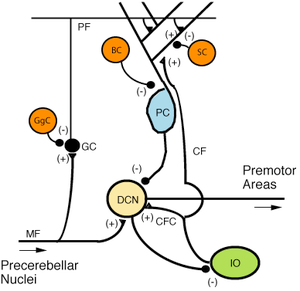Basket cell
| Basket cell | |
|---|---|
 Transverse section of a cerebellar folium (Basket cell labeled at bottom left) | |
| Details | |
| Location | Cerebellum |
| Morphology | multipolar |
| Function | Inhibitory interneuron |
| Neurotransmitter | GABA |
| Presynaptic connections | Parallel fibers |
| Postsynaptic connections | Purkinje cells |
| Identifiers | |
| NeuroLex ID | Basket Cell |
Basket cells are inhibitory GABAergic interneurons of the brain, found in the molecular layer of the cerebellum, the hippocampus, and the cerebral cortex.[1]
Anatomy and Physiology
Basket cells are multipolar interneurons that function to make inhibitory synapses and control the overall potentials of target cells. Their cell bodies can be found in molecular layers. The dendrites of basket cells are free branching, contain smooth spines, and extended from 12 to 30 mm. Basket cells have shown to form axo-somatic synapses.[2] The branched axonal arborizations give rise to the name as they appear as baskets surrounding the soma of the target cell.[3] By controlling the synapses of neurons, basket cells can directly control the action potential discharge rate of target cells.[4]
Cerebellum

In the cerebellum, the multipolar basket cells have branching dendrites, which are dilated and knotty. Basket cells synapse on the cell bodies of Purkinje cells and make inhibitory synapses with Purkinje cells. Cerebellar basket cell axons fire inhibitory neurotransmitters such as GABA to Purkinje cell axons, and inhibits the Purkinje cell.[5]Purkinje cells send inhibitory messages to the deep cerebellar nuclei and are responsible for the sole output of motor coordination from the cerebellar cortex. With the work of the basket cell, Purkinje cells do not send the inhibitory response for motor coordination and motor movement occurs.[6]
Hippocampus
Hippocampal basket cells target somata and proximal dendrites of pyramidal neurons. Like their counterparts in the cortex,[7]hippocampal basket cells are also parvalbumin-expressing and fast-spiking. In the CA3 region of the hippocampus, basket cells can often form recurrent inhibition loops with pyramidal cells.[8] Projections from a pyramidal cell will innervate the basket cell, which in turn has a projection back onto the original pyramidal cells. Since basket cells are inhibitory, this generates a closed loop that can help dampen excitatory responses.
Cortex
In the cortex, basket cells have sparsely branched axons giving off small pericellular, basket-shaped elaborations at several intervals along their length. Basket cells make up 15-25 % of total neurons in the cortex.[9]There are three types of basket cells in the cortex, the small, large and nest type:[10] The axon of a small basket cell arborizes in the vicinity of that same cell's dendritic range, this axon is short. In contrast, large basket cells innervate somata in different cortical columns due to a long axon.[9]The nest basket cells are an intermediate form of the small and large cells, their axons are confined mainly to the same cortical layer as their somata. Nest basket cells have "radiating axonal collaterals" between that of large and small basket cells. They are included as basket cells because they are interneurons that perform axo-somatic synapses.[9]
Additional images
-

Microcircuitry of the cerebellum. Excitatory synapses are denoted by (+) and inhibitory synapses by (-). Basket cell labeled BC.
-

Cerebellum.
-

Cerebellum
-

Cerebellum Microscopic Photo
External links
- Cell Centered Database - Cerebellar basket cell
- NIF Search - Basket Cell via the Neuroscience Information Framework
References
- ↑ Jones, Edward (1984). Cerebral Cortex: Volume 1: Cellular Components of the Cerebral Cortex. Springer. ISBN 978-0-306-41544-9.
- ↑ Jones, EG; Hendry, SHC (1984). "Basket cells". In Peters, A; Jones, EG. Cerebral cortex: cellular components of the cerebral cortex. New York: Plenum Press. pp. 309–34.
- ↑ "Stahl's Essential Pharmacology".
- ↑ Cobb, S. R.; Buhl, E. H.; Halasy, K.; Paulsen, O.; Somogyi, P. (1995). "Synchronization of neuronal activity in hippocampus by individual GABAergic interneurons". Nature. 378 (6552): 75–8. Bibcode:1995Natur.378...75C. doi:10.1038/378075a0. PMID 7477292.
- ↑ Southan, A. P.; Robertson, B (1998). "Patch-clamp recordings from cerebellar basket cell bodies and their presynaptic terminals reveal an asymmetric distribution of voltage-gated potassium channels". The Journal of Neuroscience. 18 (3): 948–55. PMID 9437016.
- ↑ Tan, Y. P.; Llano, I. (1999). "Modulation by K+channels of action potential-evoked intracellular Ca2+concentration rises in rat cerebellar basket cell axons". The Journal of Physiology. 520: 65–78. doi:10.1111/j.1469-7793.1999.00065.x. PMC 2269558
 . PMID 10517801.
. PMID 10517801. - ↑ Contreras, Diego (2004). "Electrophysiological classes of neocortical neurons". Neural Networks. 17 (5–6): 633–46. doi:10.1016/j.neunet.2004.04.003. PMID 15288889.
- ↑ Bryne, John. "Feedback/recurrent inhibition: Feedback inhibition in microcircuits". Neuroscience Online. University of Texas Health Center.
- 1 2 3 Wang, Y.; Gupta, A; Toledo-Rodriguez, M; Wu, C. Z.; Markram, H (2002). "Anatomical, Physiological, Molecular and Circuit Properties of Nest Basket Cells in the Developing Somatosensory Cortex". Cerebral Cortex. 12 (4): 395–410. doi:10.1093/cercor/12.4.395. PMID 11884355.
- ↑ Fox, Kevin. Barrel Cortex. Cambridge University Press. pp. 55–6.